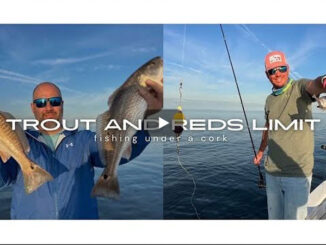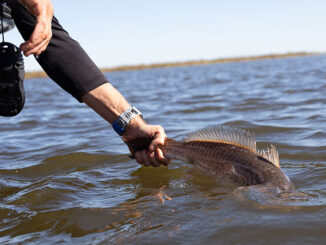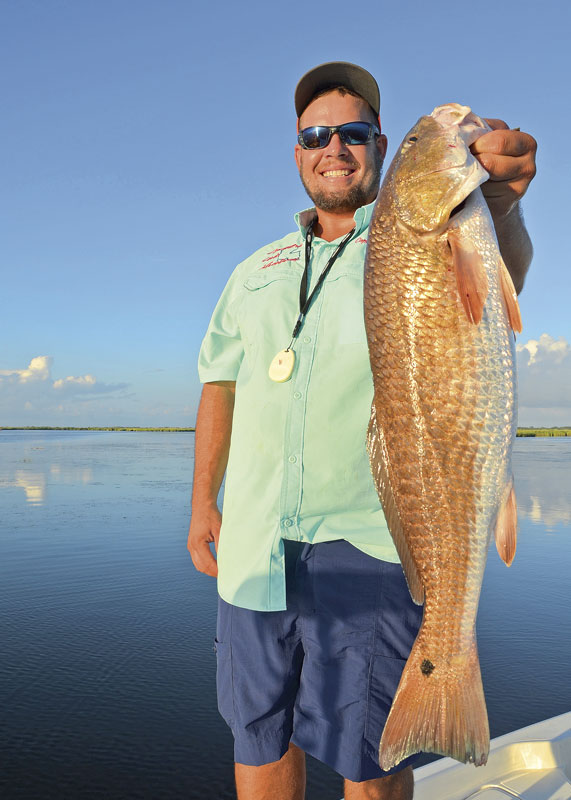
Schedule a visit with big fish by concentrating on these areas
Small baitfish huddled together, each fighting against the tidal flow pushing them out toward open water as the current created a riffle at the tip of a small grassy point in this vast Louisiana marshland.
Behind the point, the obstruction formed a small eddy. A spinnerbait splashed just beyond the point on the upstream side. In the relatively clear green water, the gold blades flashed as the lure approached the point and then rounded it. WHAM! A big redfish engulfed the swirling temptation and headed for open water.
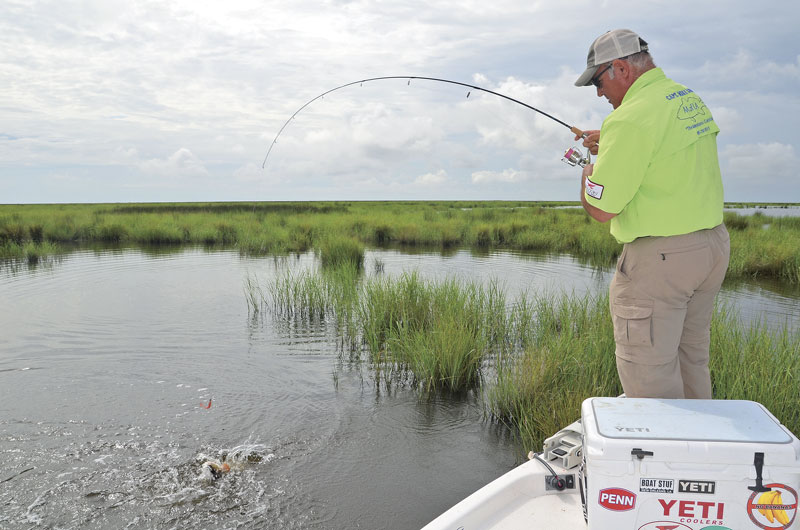
Legendary angler Bill Dance once said, “Points point to fish.” While he said that about largemouth bass, the same holds true for saltwater. Anything a largemouth will eat, a redfish might grab and vice versa. In brackish tidal marshes, reds and bass commonly hunt in the same places and feed on the same forage.
“The great majority of my clients that want to catch redfish are bass fishermen,” reported Mike Gallo, owner of Angling Adventures of Louisiana and the Spots & Dots Lake House lodge (985-781-7811, www.AAofLA.com) in Slidell. “They already know how to work lures around cover, so they’re used to fishing points.”
Altered water flow
Broken weedy shorelines pockmarked by mini coves, very common habitat in Louisiana marshes, make uncountable small points that can hold redfish. Most people only think of “points” as observable land jutting out into the water, but points can take many forms. A “point” could include fallen objects, grassy edges, bulkhead corners, dock pilings, riprap and many other forms, perhaps even a sunken boat. Anything making a protrusion or a sharp edge that alters water flow creates an excellent place for redfish to ambush prey.
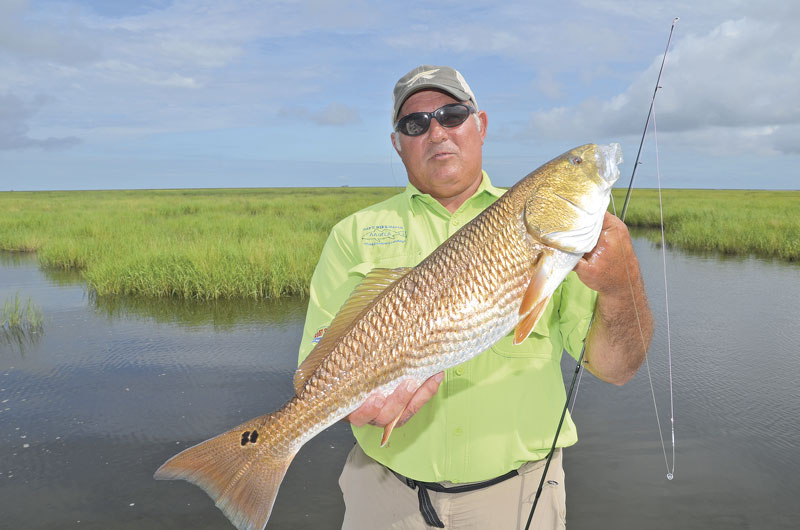
Reds normally bite best during some tidal movement. Water movement positions fish and bait. Winds can also cause or change currents. Strong breezes regularly overcome tides in the Louisiana marshes. Flowing water can also stir up bait, like small fish, shrimp, crabs and other morsels. Points constrict and redirect tidal flow.
“I look for shallow flats about two to three feet deep with areas of moving water around points or cuts and drains from duck ponds,” said Tim Ortego of Louisiana Livin Adventures (985-209-1812, Facebook) in Chauvin. “In the summer, redfish push shallower in the early morning and late evening.”
Many people believe that fish always hold behind objects out of the current waiting to ambush anything that comes along, but that’s not always true. Redfish do that, but they also roam around looking for food. Many sea creatures feed by filtering water of larvae and plankton. They typically position themselves upstream of an obstruction facing into the current so they can eat. Redfish go where they find bait.

Off the point
“A bass will sit on a point or a log for a long time, but a redfish might be 20 yards past the point,” Gallo said. “Redfish cruise back and forth along a shoreline looking for something to eat. Redfish like to use the bank as a dead end. If a redfish is a foot from shore and flushes a minnow or a crab, it chases it toward the shoreline where it runs into a dead end. They do the same thing around grassy islands. They go around and around those islands. An island is kind of a never-ending point.”
Small ditches draining marshy ponds create mini deltas with points marking either side of the channel mouth. These drains make outstanding places to catch redfish. Toss a popping cork tipped with a live or plastic shrimp as far as possible up the drain. Suspend the bait just off the bottom so the rig drifts naturally with the tide. Do the same thing with a cork around points. Cast it to the upstream side and let the wind or tide carry it across the point.
“I like a popping cork with 18 inches of 40-pound test monofilament tipped with a 3/0 Kahle hook,” Ortego said. “I bait it with either a live or fresh shrimp. That will fill up a boat with beautiful Louisiana slot redfish, but don’t be surprised if a big bull red hits it, even in the interior marsh.”
An unweighted plastic shrimp also makes a fantastic enticement in these drains. If necessary, attach a small split-shot to the line for casting. Use the lightest weight possible. Let the tidal current carry the morsel naturally downstream. Just crank the reel enough to take up the slack. If the bait stops moving, raise the rod to get it back in the flow.
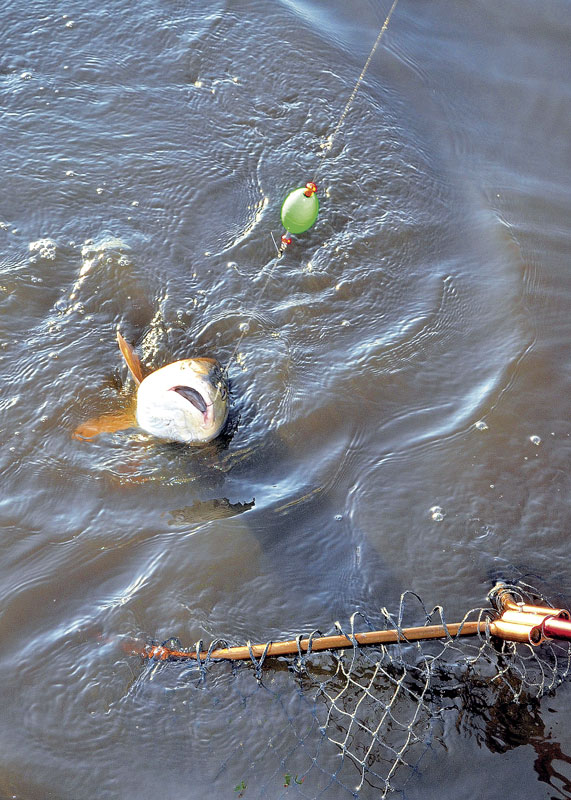
Spoon fed reds
Anglers can fish points in many ways with anything that might tempt a redfish. A rattling crankbait, spinnerbait with a big thumping gold Colorado blade or a spoon should do the trick. Many people throw topwaters around a point. In calm water, use a popper and pause between “pops.” When fishing a strong current, work a walking bait vigorously.
“During the summer, a ¼-ounce gold Johnson Weedless gold spoon or a spinnerbait with a gold Colorado blade tipped with a black and chartreuse plastic shad will get the job done,” Ortego said.
Approach any point with stealth and make extremely long casts to avoid spooking fish in shallow water. Always start downstream of the point and throw baits past it. Work baits down with the current at first. Then, move forward slowly, hitting every piece of structure from various angles to find where fish want to stay.
In the summer, water temperatures in shallow marsh ponds become unbearably hot for fish. In addition, ponds with dark water and dark muddy bottoms absorb more heat. Hot water quickly loses oxygen. When water becomes too hypoxic, fish and other creatures go elsewhere or die.
During summer swelter, anglers might need to abandon their favorite spring and fall honey holes to seek fish in cooler, deeper, water. Flowing water runs cooler than still water and traps more dissolved oxygen. Look for signs of life other than garfish or mullets, which can survive in water where other fish cannot.
“I look for what I call ‘the holy trinity of fishing’ — clean water, moving water and life,” Gallo said. “The places with the most life indicate more oxygen in the water. Places where the marsh meets large lakes and bays are more exposed to oxygen, especially if there’s wind. That’s where most of the life will be in the summer. If the water is too clean, I can see redfish, but they can see me too.”
After getting a bite, try to determine a pattern. Note everything, the water depth, position of the fish upstream or downstream, type of bait used and how. After determining a pattern, try to repeat it. Eliminate unproductive waters to concentrate on those spots that hold the most active fish. In a system as dynamic as the Louisiana marshes, conditions and patterns change frequently.
“Fishermen know what ‘match the hatch’ means, but they might not think of ‘match the vibration,’” Gallo said. “Fish live in a 3-D world surrounded by sounds. Their lateral line is their sonar. They key in on certain vibrations in the water. If a minnow swims against the current, it’s giving off a certain vibration. I try to find a lure that’s proportional to the tide so I can match that vibration of the minnow in that tide.”
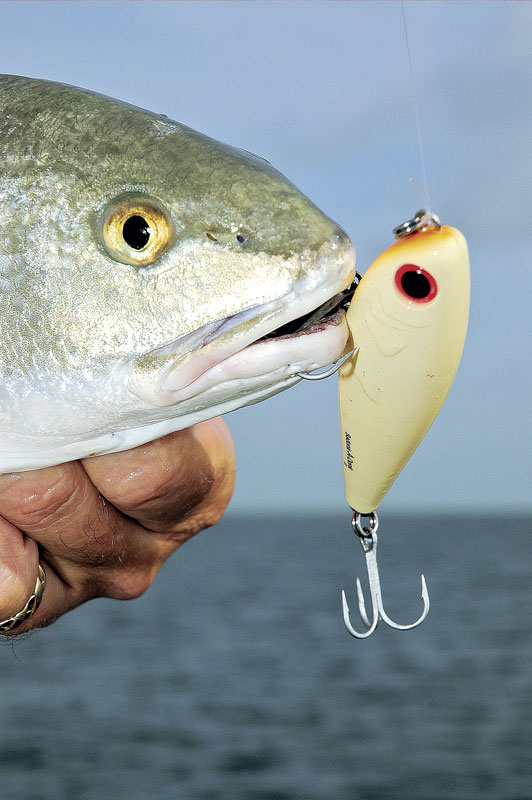
Go deep to score
Usually, anglers only see a small section of a point. A long, sloping landform could extend far out into a waterbody. These formations might hold fish all along it. In the blistering summer, redfish tend to hunt in the deeper water near an object. With modern electronics, anglers can easily detect these formations and might even spot fish on them. Anglers might also discover oyster reefs, sandbars and troughs or other submerged structures that hold fish.
“Points are great places to fish, but most people just concentrate on the part of the point they can see,” Gallo said. “Often, that point extends far out under the water. Fish might be up closer to the grass or farther from shore, but still hanging around that point. A great point for redfish in August could be a great point for trout in October or November.”
Around these long, sloping points, toss spinnerbaits, spoons or crankbaits that resemble mullets. Work baits parallel to the structure just over the drop-off edge. In the summer, run baits just over the bottom. Use crankbaits that dive slightly deeper than the water depth. Reel it down to the bottom so the lip digs into the silt. Pause and it will float up backwards. The lip makes a mud trail that simulates a crab scurrying over the bottom.
Breaks in jetties also create superb points that might hold redfish. Off jetty ends, currents whipping around the tip scour holes, good places to drop Carolina rigs baited with live mullets, shrimp or pogies for bull reds.
Certainly no secret, points and the areas around points can lead to incredible action, as Bill Dance said. When fishing a Louisiana marsh or coastal bay, never pass up an opportunity to make your personal “a-point-ment” with big redfish!
